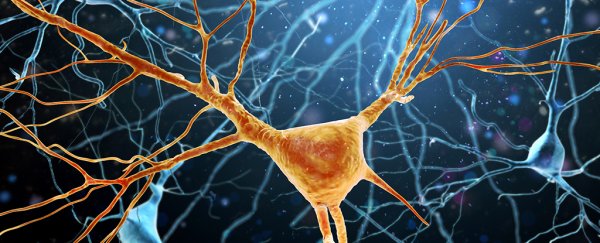Human brain cells have been found to carry electrical signals in a fashion that could significantly increase the power of individual neurons.
Comparing the speed of signals travelling down the branches of human neurons with similar cells taken from rats, researchers have found a difference in signal strength that hints at deeper processing.
New research led by scientists from MIT took advantage of an opportunity to retrieve a fingernail-sized sample of excitatory neurons from deep inside the brains of volunteers undergoing surgery for epilepsy.
The tissue was removed from a section of the anterior temporal lobe that could cope with the loss of a few neurons, so didn't affect the patients in any way.
But it did provide the researchers with the right kind of tissue to observe how human nerves manage to carry electrochemical messages across long distances.
It's no secret that despite being as smart as they are, rats have rather tiny brains with a comparatively thin outer cortex. (No offence to any rats reading this.)
But that thin outer layer is also organised in a similarly layered fashion to our own, raising the question of how our own neurons deal with sending signals over longer distances.
The text-book neuron typically resembles a tree stripped of its leaves. Branches called dendrites collect signals from other cells and transmit them down through a cell body into a long, slender trunk called an axon.
These transmissions are in the form of charged particles weaving in and out of the neuron's membrane through ion channels, producing ripples of voltage down the cell's length.
Yet those branches are more than conduits for signals – they actively tweak the message, playing a key role in the processing of the information they carry.
In some ways, we can think of dendrites as transistors, mediating signals by amplifying some and blocking others. It now seems they can also play an even more involved role in how our nervous system processes information, at least in humans.
"It's not just that humans are smart because we have more neurons and a larger cortex," says the study's lead scientist Mark Harnett.
"From the bottom up, neurons behave differently."
Taking their sample of neurons from deep inside their volunteers' brains, the researchers immersed them in a spinal fluid-like medium to keep them alive for the next day or so, while they measured how signals travelled down their length.
Similar studies have already been carried out on rat neurons. But getting the same kind of cells out of living human brains hasn't been as easy.
"These are the most carefully detailed measurements to date of the physiological properties of human neurons," Nelson Spruston told MIT News Office's Anne Trafton.
Spruston wasn't involved in the research, but as senior director of scientific programs at the Howard Hughes Medical Institute Janelia Research Campus, he understands the significance of the study.
"These kinds of experiments are very technically demanding, even in mice and rats, so from a technical perspective, it's pretty amazing that they've done this in humans."
With comparative studies on both animals, researchers have finally been able to share notes on whether a long distance sprint makes much of a difference in signal strength.
It turns out those signals do weaken over the distance of a human neuron, far more than they do in the same kinds of cells taken from rats.
Interestingly, both kinds of cells have the same number of ion channels in their membranes, which are simply spread out a little more in our neurons. Models developed by the researchers suggest this can account for the signal's differences.
"In human neurons, there is more electrical compartmentalisation, and that allows these units to be a little bit more independent, potentially leading to increased computational capabilities of single neurons," says Harnett.
Whether this architecture can explain differences in how our species processes information is left to be seen. But it's a hypothesis well worth exploring, according to Harnett.
"If you have a cortical column that has a chunk of human or rodent cortex, you're going to be able to accomplish more computations faster with the human architecture versus the rodent architecture," he says.
This research was published in Cell.
